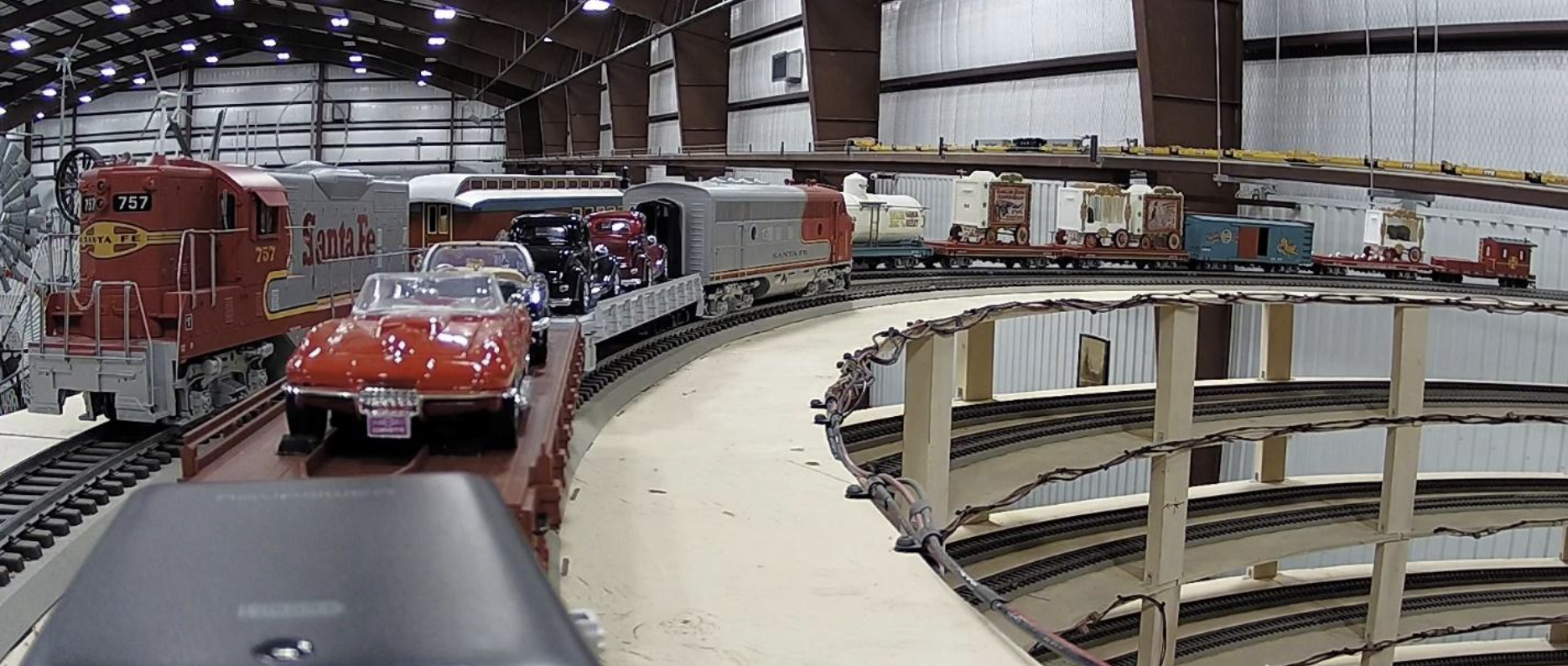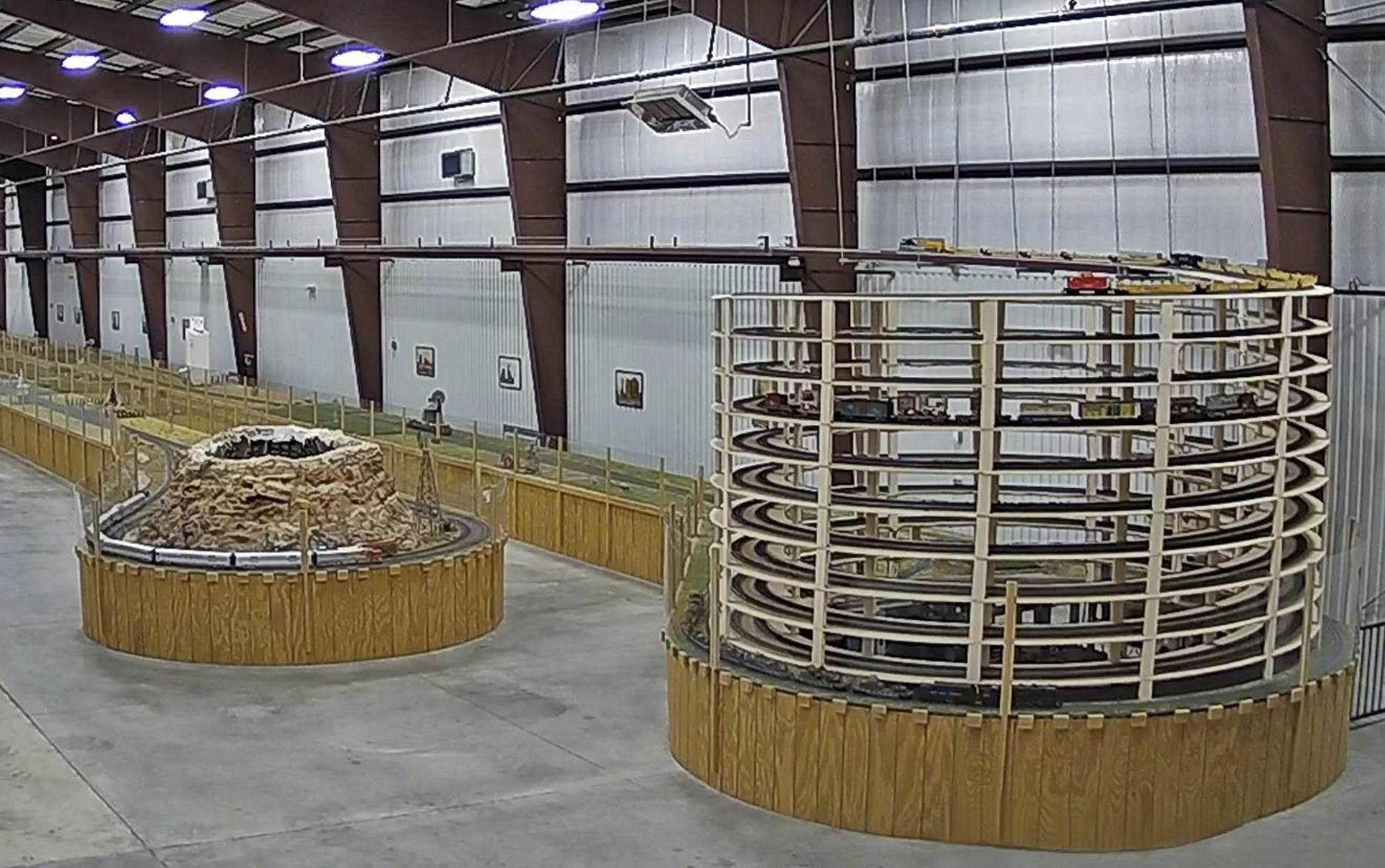Model Trains
Train System Facts:
1 Central Train Control Computer
2 Remote Train Control Computer
1 Programming Computer
1 Train Video Control Computer with 2 Video Monitoring Systems
3 Wireless Network Channels
5 Computer Control and Configuration Programs
5 Video Monitors

The Layout
This wing of the American Windmill Museum was designed to display not only windmills but also a model train system celebrating the historical relationship between windmills and railroads.
The large layout uses G-scale (Garden scale -1/29) trains which are typically found in gardens or back yards. It is unusual to find them operating indoors. In addition, there is a small “Z” scale model train on the main layout; as well as, two “HO” scale trains running on a separate track.
The model layout has approximately 4,000 feet of stainless steel track. Trains run around two circuits, a lower one of 900 feet or 5 scale miles and, an upper circuit of about 2,100 feet. Trains running on both the lower and upper circuits travel a total of 3,020 feet (16 ¼ scale miles). Each circuit is double tracked.
The beginning of the upper circuit has a spiral helix, the world’s largest. This helix has 10 levels on a 2% grade for 450 feet or 2-1/2 scale miles with a vertical rise of 9 feet or 260 scale feet.
The layout has 27 turnouts or switches which allow the trains to go from one track to another. There are 3 bridges and one tunnel. Seventeen home sidings allow trains to park without impeding the travel of other trains. Four work sidings are used where parked trains can be maintained, repaired, or programmed. Schedules can run 10 trains at the same time over the large layout.
There are 12 custom built houses, 34 buildings and a 1940 vintage downtown Lubbock which is dominated by the original Lubbock Hotel. The first train station in Lubbock has as its neighbor the Slaton Harvey House.
There are 36 scale windmills and 5 railroad windmills, each one printed on a 3-D printer. These railroad windmills have scale 15,000 gallon storage tanks for the steam engines. A well drilling rig and an example of how windmills were erected with gin poles are both modeled.
In the middle of the lower level is the world famous, Clock-faced Cone Elevator. In the right position, you can see the “5 till 5” clock face formed by the word “CONE.” Additional HO, N and O scale train layouts are located on the west side of the building.
It took 3 years to design and build this train layout. Another year and a half was spent installing and debugging the operating system. Fine tuning the software with its numerous hardware interfaces is an on-going task.

The Control System:
This large railroad layout would be virtually impossible to operate without the sophisticated computer control system. A visual, computerized layout of the track provides a real time picture of the trains, their movements, location and the status of every switch and schedule.
With this type of control, the operator knows where trains are going and how fast. The program looks at when and where a train is approaching a common track area or turnout switch. There are rules governing each train’s movement and which train has priority as trains stop and wait until the track is clear.
Individual train schedules have been programmed into the computer for running on either the lower circuit or the upper circuit. The train engineer or an operator at the front desk can pick an individual or groups of schedules to run.
The train control program (TrainController-Gold from Germany) communicates with the DCC (Digital Command Control) Electronics which includes 40 power supplies and 60 boosters supplying AC power to the tracks. There are 73 occupancy detectors which verify and transmit train position to the computer as the trains travel throughout the layout.
The computer talks to the command control electronics using a LocoNet communication network. The DCC electronics provide power and talk to the locomotives over the tracks. Locomotives have decoders which receive the network signals and control the speed, lights and sounds that are programmed into the system for each train.
There is approximately 7,000 feet of power wiring and 5,000 feet of network control wiring connected to 60 separate 110 volt electric circuits.
With any system that has many moving parts – locomotives, cars, and track components – there are occasional mechanical problems and these can cause train wrecks or derailments. In addition, computer bugs and related electronic issues can cause havoc.
Monitoring System
Twelve fixed video cameras monitor train movements which are shown on screens in the shop area. There is a wireless video camera mounted on one of the train cars which shows a picture on the monitor positioned on the bench work. This camera gives a realistic view of the trains as if you were a passenger traveling on the train. It is also great fun to see yourself and friends wave as the camera train whizzes by. Sometimes the train engineer might wave back to you as you walk by!
Take your own pictures or movies of this monitor with your phone or camera. The Windmill Museum does not record or save any video footage of visitors.
You can follow us on Facebook or Instagram. Thank you for your interest and support.
